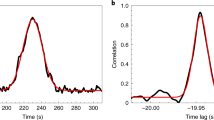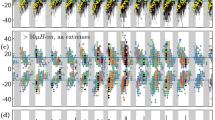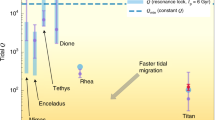Abstract
CARPENTER1 noted in 1966 that the radar observations of the rotation period of Venus gave a figure remarkably close to one at which Venus would present the same aspect to the Earth at each inferior conjunction. Goldreich and Peale2 discussed this as a possible resonance with a gravitational couple exerted by the Earth on a permanent transverse quadrupole moment of Venus, but noted that such a couple would be expected to be much smaller than that due to the Sun acting on the solid body tide. The rotation would continue to slow down due to tidal friction, and could not have been arrested in the resonance. We therefore proposed3 that the solar couple on thermal atmospheric tides might be expected to apply an acceleration to the spin of Venus, thus opposing the body tidal frictional deceleration. (An effect in that sense occurs for the Earth.) The two opposed torques would have a different dependence on the rotation speed of Venus, and might balance at a particular value. As the rotation speed approached this value, the torque necessary for capture into a resonance would have become very small, and the effect exerted by the Earth might then be sufficient. A diurnal pressure wave of as little as 1 mbar could balance the body tide. Ingersoll and Dobrovolskis4 have reconsidered this suggestion, and attempted a quantitative calculation of the atmospheric tide. Although their result seems to favour the theory, we show here that their approach is not valid. Ingersoll and Dobrovolskis consider a quasi-static atmosphere heated diurnally, and then calculate the mass distribution and hence the solar couple that results. But the quasi-static assumption is not justified for the known circumstances on Venus. Wind speeds must be expected5, and have indeed been observed6, that cause an advection of heat substantially faster than the motion of the subsolar point over the surface (∼4 m s−1); in these circumstances the atmospheric mass distribution will be determined by the dynamics of the convecting atmosphere. (The acceleration terms rather than temperature make the main contribution to horizontal variations of pressure and density.) A secure result cannot be obtained until the flow patterns and velocities are known, from a detailed theory of planetary convection, or from direct observation.
This is a preview of subscription content, access via your institution
Access options
Subscribe to this journal
Receive 51 print issues and online access
$199.00 per year
only $3.90 per issue
Buy this article
- Purchase on Springer Link
- Instant access to full article PDF
Prices may be subject to local taxes which are calculated during checkout
Similar content being viewed by others
References
Carpenter, R. L. Astr. J. 71, 143–152 (1966).
Goldreich, P. & Peale, S. J. Nature 209, 1117–1118 (1966); Astr. J. 72, 662–668 (1967); Astr. J. 75, 273–284 (1970).
Gold, T. & Soter, S. Icarus 11, 356–366 (1969).
Ingersoll, A. T. & Dobrovolskis, A. R. Nature 275, 37–38 (1978).
Young, R. E. & Pollack, J. B. J. atmos. Sci. 34, 1315–1351 (1977).
Keldysh, M. V. Icarus 30, 605–625 (1977).
Belton, M. J. S., Smith, G. R., Schubert, G. & Del Genio, A. D. J. atmos. Sci. 33, 1394–1417 (1976).
Gold, T. & Soter, S. Icarus 14, 16–20 (1971).
Gierasch, P., Goody, R. & Stone, P. Geophys. Fluid Dyn. 1, 1–18 (1970); Golitsyn, G. S. Icarus 13, 1–24 (1970).
Crisp, D. & Young, A. T. Icarus 35, 182–188 (1978).
Author information
Authors and Affiliations
Rights and permissions
About this article
Cite this article
GOLD, T., SOTER, S. Theory of the Earth-synchronous rotation of Venus. Nature 277, 280–281 (1979). https://doi.org/10.1038/277280a0
Received:
Accepted:
Issue Date:
DOI: https://doi.org/10.1038/277280a0
This article is cited by
-
Dynamical evolution of the rotation of Venus
Earth, Moon, and Planets (1988)
Comments
By submitting a comment you agree to abide by our Terms and Community Guidelines. If you find something abusive or that does not comply with our terms or guidelines please flag it as inappropriate.



